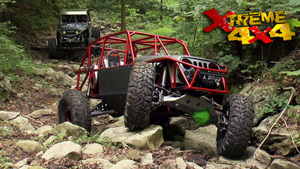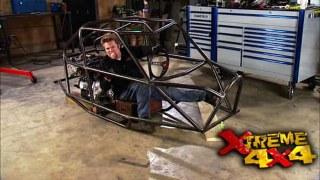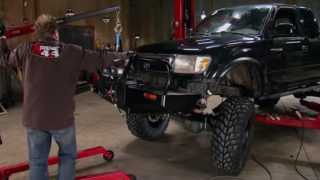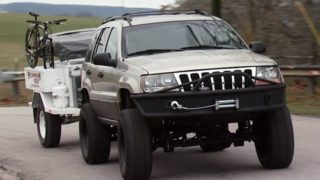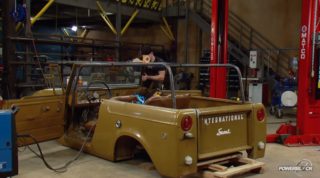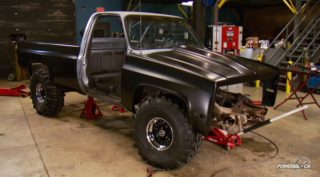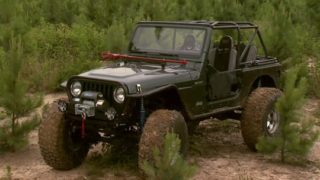More Budget Buggy Episodes
Xtreme 4x4 Builds
Want more content like this?
Join the PowerNation Email NewsletterParts Used In This Episode
2020 Software Solutions, Inc.
Bend-Tech PRO software.
Ballistic Fabrication
Ballistic Hybrid Coilover/Air Shock and coil springs.
Dupli-Color
Dupli-Color Red Metalcast, Spray-on Truck Bed Coating, Dupli-Color Metal Specks Sparkle Silver
O'Reilly Auto Parts
Replacement Radiator
Pitbull Tire Company
ROCKER Extreme Off-Road 42x15.0-15.
Summit Racing
Fuel Cell, Aluminum, Natural, 3 Gallons.
Warn Industries
WARN 9.0Rc winch.
Episode Transcript
Building on a budget means different things to different people. But today on Xtreme 4x4, you can't get a paint job done any cheaper than with a rattle can. We'll show you how to do it right and get eye popping results. Plus we'll travel 1500 miles to show you two of America's Top trails plus one that was world class until it was padlocked. Xtreme 4x4 starts. Now,
recently on Xtreme 4x4, we decided that we wanted to put together a small single seat, four wheel steer crawler on a realistic budget. Now, we did it in an area of a shop that we're calling a two car garage fab shop. We put it all together underneath our mezzanine.
And the last time you saw this chassis, it was sitting on tires and wheels and was a true rolling buggy.
The project started with a Ben Tech Pro assembly file that we got from our buddy Jeremy Winters.
Now, we watched his crawler go from a pure idea to an awesome one of a kind single seat four wheel steer buggy for under 10 grand. So we knew we had to have one of our own
bent up some tubing, put together a chassis
and slipped in a truly unique drive train,
Acura Integra four cylinder and a Honda Civic Transaxle.
Finally to finish it off, tossed together a set of killer Toyota steering axles, front and rear
bolted up a set of 42 inch tall pit bull rockers
and sat it down on some ballistic fabrication, hybrid coil over
shock.
Now, between then and now we went ahead and completely tore down the buggy and then went ahead and finish welded the entire chassis. Now, believe it or not, it took us over 12 hours worth of welding to make sure that we hit all the joints and didn't miss anything, turning the buggy onto its side and then onto its roof and back onto its belly pan. The last thing we wanna do right now is miss a joint or worse, forget about a tab that
we need later to bolt something off because right now we are ready to have this chassis custom painted. Now, when you're dealing with a very small tube chassis like this, it is honestly sometimes hard to find a body shop even willing to tackle the job. They're gonna have a great big paint gun. They have to crawl around on the inside of this buggy and try to spray everything out. But you can get a high quality automotive finish on a chassis like this in your garage just using aerosol cans.
Now, the key to getting a somewhat custom paint job just using aerosol cans is to think outside the box a little bit. Don't just grab a color that you like and spray it on the chassis, try some new things. There's a lot of new products out there that you can actually layer on top of each other. Now, what I have here are three different products all from duple color and I've come up with what I think is a pretty unique three stage paint job
using a piece of scrap tubing will start with a base of bed liner. Now, this will not only seal the tube but it will also give the paint a little bit of a texture, making it look like powder coat
and we'll lay down two coats of dup color sparkle silver. Now, this is a silver metallic that has different size metal flake in it. So it gives it some extra pop
and we'll follow it with the red metal cast
anodizing and this is a seer anodizing coating designed to be sprayed over chrome. It'll give us a deep cherry look
with the tube out in the sun. You can really see the depth of this paint almost looks like a candy coat.
The first step is to prep the entire chassis to remove any oil or grease from the tubing
and we'll start on the inside and that way we won't be leaning over wet. Paint
safety is important here. Make sure you work in a well ventilated area
and wear a mask. Trust me, fumes from a spray bomb can make you go a little loopy,
use multiple light coats instead of one heavy coat. This will prevent runs in the paint.
Now, we're not just gonna stop with some custom paint on this buggy. We're also gonna put some body panels on it and then have a custom wrap made, basically a big sticker to cover it up, make it look cool. That'll save us a little bit of money because it's a little bit cheaper than having custom paint done. Plus if we scratch it, we can just get another sticker printed out. Now, you can use a bunch of stuff to make body panels pretty much any metal, even Lexan or Plexiglass. If you still want to be able to see your tires when you're sitting in the driver's seat, we're gonna make ours out of 0 90 aluminum, but either way it always starts with a good cardboard template.
Now, the hood and the two sides of this buggy will be the only panels that get the big sticker or wrap applied to it. And what we have to do now is take a picture of these two panels and then email it over to the wrap company so they can start to work on the design. The problem is when we take a picture, it's obviously not going to be the scale. So what we have to do now is
a small square on each panel, mark it and then mark every inch. So when they're looking at it, they can actually see how big the panel is. Then they'll ship the sticker to us and we can just apply it right here in the shop. Now, I still obviously have to make the other side of the buggy for that panel and then do all the interior stuff. That's what we're gonna do right now.
Coming up, find out why the government closed arguably one of the toughest series of trails in the east and learn what you can do to prevent this from happening again. Stay tuned.
A question that I get asked a lot is where can I go? Four wheeling. Well, no matter where you live in this country, there's tons of public and private land with millions of miles of trails for you to enjoy.
You
want
the flaky sandstone of Choke Cherry Canyon offers up one of the most hardcore off-road experiences anywhere
located outside the town of Farmington, New Mexico. You'll find glade run recreation area.
19,000 acres of public federally managed land.
You've got two choices here. 43 miles of limited mark trails and nearly 4000 acres of open Ohv. Being local here in town, we're very fortunate to have all this out here. It's just a maze. It's trails. Everywhere you go, you'll see black marks going up, uh
steep ledges and boulders and it's just opportunities are unlimited.
There's no real restrictions on where you can and cannot go.
So it's pretty much you come out and the Choke Cherry Can and you just
go at it.
We go,
I've conquered every wheat field in Kansas.
But uh this is a little different.
This ride was put on by local members of the cliffhangers. Four by four club.
Appropriately named
since the Rim Trail here has a pretty high pucker factor.
You see your hands,
we got about a 60 70 ft drop off
and you got some pretty good climbs just right on the side, not real hard, kind of off camera. And it's more of a fear factor.
You know, looking over the edge, you know,
some of them pretty easy. Some of them are really hard, you know, probably in the five range.
Some of the competition climbs are a one shot deal. You either make it or you don't,
you can't describe the feeling that you get after,
after doing that the way your, your hair feels like it's standing up and it's
running the chills up the back of your neck. It's got to be the,
the greatest adrenaline rush. I get out of anything else, drag racing, mud, logging, whatever,
bring it hard.
If your idea of wheeling excitement is quite a few notches below this,
then we'll head east of the Mississippi where on the Kentucky and Tennessee border, you'll find land between the lakes
100 and 70,000 acres. Rest between Kentucky Lake and Lake Barkley.
It's managed by the US Forest Service. The same government agency who locked the gates on undeniably one of the most popular off road trails in the East
Upper Tellico
Ohv. In North Carolina,
the feds here claimed recreational Wheelers were causing extensive damage to the ecosystem contributing to unacceptable levels of sediment into the Tellico River and its tributaries
that remains to be seen since the final environmental analysis on Tele
has not been made public.
In the meantime, one of our favorite places to wheel is padlock,
slick Rock closed.
Now
two close
guard rail close
all 39 miles of trails closed.
Thousands of wheelers access to this public land
which brings us back to land between the lakes and Turkey Bay ob
officials here are proactive in promoting responsible wheeling
and although nowhere near as challenging as Tellico,
these trails remain open.
The for
service believes that and supports that. Ohv Riding is a valid use of public land, but we all have to work together to find a way to make it sustainable for all the generations to come after us. That's what we like to hear.
How do they control sediment run on?
What was happening here before we put these blocks in was
it was a low water creek crossing,
a high impact area on the main trail and we had riprap sunk within the soil. But over time through storm events, spinning tires. Uh the riprap began to churn out.
So what we've implemented here is a hardened stabilization with interlocking cable blocks. This is a stream that constantly holds water so there's always flow.
This is just going to help keep this one specific sensitive area.
Uh hold up in the long run a little bit better.
Turkey Bay offers up 100 miles of nice wide trails on the difficulty scale. They're about a two.
But if you love nature, you can wheel during the day, camp fish plus good. But as close to a bison and an elk as you can imagine.
So how can you help keep your local ohb open.
A volunteer volunteer at the guard shack, participate in the clean up days, get on their mailing list and they'll keep you updated on what's developing through the government through their programs.
Just volunteer. That is the best thing that you can do as long as we can continue to co our coordinating with the National Forest Service of the, uh, the volunteer activities.
I, I see no problem that we cannot keep this open, but it's gonna take everybody working together.
Now, that's some great advice to help keep public land open to the public. Now, there should be local groups in your areas that are called the Friends of organizations that take care of specific trails where you live. But don't forget about national groups like the Blue Ribbon Coalition. They're out there fighting to keep our trails open. Every day of the week,
we're back on a stream and putting our single seat buggy back together, tearing this thing down to paint. The entire chassis was definitely the right move. It'll really set this buggy apart when we're out on the trail.
Now, even though our buggy is incredibly small, we still want a winch on the front of it for a couple of different reasons. Obviously, first of all, if we get stuck, we can pull it out and pull the buggy out to get it back on the trail. But more importantly, if we take this buggy out, we get it high centered on an obstacle, come up onto a big rock and it just basically hung up on the skid plate. We can compress the front suspension using the winch. We'll simply attach it to the front axle and draw it in. What that will do is bring the center of the gravity of the buggy more towards the front and we'll hopefully just
roll off that obstacle. Competitive rock crawlers do it all the time. Now, since the buggy weighs in at just under 2000 pounds, we don't need a full blown big winch. So we opted for the worn 9.0 RC winch. Now, the RC stands for rock crawling and this is a competitive rock crawlers winch. It's obviously a lot smaller than a full size winch, but it still has a 9000 pound line pull and it uses synthetic rope instead of aircraft cable. Now, the size of this winch, as well as the pulling power make it ideal for our little buggy.
Now, the small buggy sometimes packaging can become an issue, but we lucked out because of our small four cylinder engine. We don't need a really large fuel cell to handle an entire day of wheeling. So we're gonna install this small three gallon aluminum fuel cell that we got from summit racing. Now, the nice thing about these small cells is they have foam inside them. That foam will keep the fuel from sloshing around when you're riding on the trail and keep it from flowing out of your overflow vent. All we have to do now is bolt this into the back run the fuel lines. Once the motor is back in,
we were able to source a stock geometric radiator that will help keep our four cylinder perfectly cool
and a fan because
everyone loves having fans.
You're watching Xtreme 4x4 for a DVD copy of this episode. Just go to Power Block tv.com and order your copy for just 595 plus shipping and handling. Start your own Xtreme 4x4 collection delivered right to your door from the power block.
Now, right now on extreme, we're gonna be starting something a little bit new now. Sure. We build a ton of trail trucks, some serious two buggies and even some Jeeps. But we know that a lot of you guys out there have trucks just like this, you drive them on the street every day and maybe every now and then you take them out on the trails to do some light wheeling. And this is a pretty good base truck, mid-nineties, dodge, solid axle front. It's actually a great truck for that purpose. The downfall is when you lift the truck up like this, put a big tires and wheel package on it, you're gonna blow the fuel economy right out the window. So what we're gonna do is we're gonna take this truck, we're gonna do a couple of little tips and tricks to it to improve your fuel mileage as well as make it a better off road truck. We're gonna keep track of all the data and then you'll know what will improve your fuel mileage and what won't right now, this truck rocks about eight miles to the gallon with a good mix of highway and city driving. We're gonna try and get this truck up to close to 20
MPG, but still make it strong enough that you can go wheeling and big enough that it'll look good on the road.
Now, the first little trick we're gonna try to save a little bit of money on fuel is under the hood. Now, the V8 in this truck is just like most domestic pickups and the fact that it has a mechanical clutch fan at the front of the motor to keep the engine cool. That fan is driven by the engine as it turns and it draws air across the radio.
Now, the plan here is simple. We're going to remove the mechanical fan and therefore remove that load from the engine to keep the radiator cool. We'll install an electric fan that way we'll be using power from the battery to keep our truck cool instead of power from the motor by saving that power in the motor. Hopefully, that'll get us a little better gas mileage
the
now, obviously, we won't know what the little trick we did today does to our fuel economy until we take the truck out and drive it a lot. And that's exactly what we're gonna do. We'll roll this truck back into the shop a bunch of times in the next year and have a look at how each little upgrade affects the truck's final fuel economy. At the same time, we still want this truck to be a good weekend wheeler. So we have other upgrades planned as well.
Gearing and new tires and wheels. Remember the goal here is to get close to 20
MPG, drive it every day and have a good off road wheel and truck. And today we spent less than 100 bucks and you guys could easily do this to almost any truck that has a mechanical fan, ditch it, replace it with electric fan. We'll let you know how much money we put back in our pocket. Next time we got it in the shop.
Show Full Transcript
recently on Xtreme 4x4, we decided that we wanted to put together a small single seat, four wheel steer crawler on a realistic budget. Now, we did it in an area of a shop that we're calling a two car garage fab shop. We put it all together underneath our mezzanine.
And the last time you saw this chassis, it was sitting on tires and wheels and was a true rolling buggy.
The project started with a Ben Tech Pro assembly file that we got from our buddy Jeremy Winters.
Now, we watched his crawler go from a pure idea to an awesome one of a kind single seat four wheel steer buggy for under 10 grand. So we knew we had to have one of our own
bent up some tubing, put together a chassis
and slipped in a truly unique drive train,
Acura Integra four cylinder and a Honda Civic Transaxle.
Finally to finish it off, tossed together a set of killer Toyota steering axles, front and rear
bolted up a set of 42 inch tall pit bull rockers
and sat it down on some ballistic fabrication, hybrid coil over
shock.
Now, between then and now we went ahead and completely tore down the buggy and then went ahead and finish welded the entire chassis. Now, believe it or not, it took us over 12 hours worth of welding to make sure that we hit all the joints and didn't miss anything, turning the buggy onto its side and then onto its roof and back onto its belly pan. The last thing we wanna do right now is miss a joint or worse, forget about a tab that
we need later to bolt something off because right now we are ready to have this chassis custom painted. Now, when you're dealing with a very small tube chassis like this, it is honestly sometimes hard to find a body shop even willing to tackle the job. They're gonna have a great big paint gun. They have to crawl around on the inside of this buggy and try to spray everything out. But you can get a high quality automotive finish on a chassis like this in your garage just using aerosol cans.
Now, the key to getting a somewhat custom paint job just using aerosol cans is to think outside the box a little bit. Don't just grab a color that you like and spray it on the chassis, try some new things. There's a lot of new products out there that you can actually layer on top of each other. Now, what I have here are three different products all from duple color and I've come up with what I think is a pretty unique three stage paint job
using a piece of scrap tubing will start with a base of bed liner. Now, this will not only seal the tube but it will also give the paint a little bit of a texture, making it look like powder coat
and we'll lay down two coats of dup color sparkle silver. Now, this is a silver metallic that has different size metal flake in it. So it gives it some extra pop
and we'll follow it with the red metal cast
anodizing and this is a seer anodizing coating designed to be sprayed over chrome. It'll give us a deep cherry look
with the tube out in the sun. You can really see the depth of this paint almost looks like a candy coat.
The first step is to prep the entire chassis to remove any oil or grease from the tubing
and we'll start on the inside and that way we won't be leaning over wet. Paint
safety is important here. Make sure you work in a well ventilated area
and wear a mask. Trust me, fumes from a spray bomb can make you go a little loopy,
use multiple light coats instead of one heavy coat. This will prevent runs in the paint.
Now, we're not just gonna stop with some custom paint on this buggy. We're also gonna put some body panels on it and then have a custom wrap made, basically a big sticker to cover it up, make it look cool. That'll save us a little bit of money because it's a little bit cheaper than having custom paint done. Plus if we scratch it, we can just get another sticker printed out. Now, you can use a bunch of stuff to make body panels pretty much any metal, even Lexan or Plexiglass. If you still want to be able to see your tires when you're sitting in the driver's seat, we're gonna make ours out of 0 90 aluminum, but either way it always starts with a good cardboard template.
Now, the hood and the two sides of this buggy will be the only panels that get the big sticker or wrap applied to it. And what we have to do now is take a picture of these two panels and then email it over to the wrap company so they can start to work on the design. The problem is when we take a picture, it's obviously not going to be the scale. So what we have to do now is
a small square on each panel, mark it and then mark every inch. So when they're looking at it, they can actually see how big the panel is. Then they'll ship the sticker to us and we can just apply it right here in the shop. Now, I still obviously have to make the other side of the buggy for that panel and then do all the interior stuff. That's what we're gonna do right now.
Coming up, find out why the government closed arguably one of the toughest series of trails in the east and learn what you can do to prevent this from happening again. Stay tuned.
A question that I get asked a lot is where can I go? Four wheeling. Well, no matter where you live in this country, there's tons of public and private land with millions of miles of trails for you to enjoy.
You
want
the flaky sandstone of Choke Cherry Canyon offers up one of the most hardcore off-road experiences anywhere
located outside the town of Farmington, New Mexico. You'll find glade run recreation area.
19,000 acres of public federally managed land.
You've got two choices here. 43 miles of limited mark trails and nearly 4000 acres of open Ohv. Being local here in town, we're very fortunate to have all this out here. It's just a maze. It's trails. Everywhere you go, you'll see black marks going up, uh
steep ledges and boulders and it's just opportunities are unlimited.
There's no real restrictions on where you can and cannot go.
So it's pretty much you come out and the Choke Cherry Can and you just
go at it.
We go,
I've conquered every wheat field in Kansas.
But uh this is a little different.
This ride was put on by local members of the cliffhangers. Four by four club.
Appropriately named
since the Rim Trail here has a pretty high pucker factor.
You see your hands,
we got about a 60 70 ft drop off
and you got some pretty good climbs just right on the side, not real hard, kind of off camera. And it's more of a fear factor.
You know, looking over the edge, you know,
some of them pretty easy. Some of them are really hard, you know, probably in the five range.
Some of the competition climbs are a one shot deal. You either make it or you don't,
you can't describe the feeling that you get after,
after doing that the way your, your hair feels like it's standing up and it's
running the chills up the back of your neck. It's got to be the,
the greatest adrenaline rush. I get out of anything else, drag racing, mud, logging, whatever,
bring it hard.
If your idea of wheeling excitement is quite a few notches below this,
then we'll head east of the Mississippi where on the Kentucky and Tennessee border, you'll find land between the lakes
100 and 70,000 acres. Rest between Kentucky Lake and Lake Barkley.
It's managed by the US Forest Service. The same government agency who locked the gates on undeniably one of the most popular off road trails in the East
Upper Tellico
Ohv. In North Carolina,
the feds here claimed recreational Wheelers were causing extensive damage to the ecosystem contributing to unacceptable levels of sediment into the Tellico River and its tributaries
that remains to be seen since the final environmental analysis on Tele
has not been made public.
In the meantime, one of our favorite places to wheel is padlock,
slick Rock closed.
Now
two close
guard rail close
all 39 miles of trails closed.
Thousands of wheelers access to this public land
which brings us back to land between the lakes and Turkey Bay ob
officials here are proactive in promoting responsible wheeling
and although nowhere near as challenging as Tellico,
these trails remain open.
The for
service believes that and supports that. Ohv Riding is a valid use of public land, but we all have to work together to find a way to make it sustainable for all the generations to come after us. That's what we like to hear.
How do they control sediment run on?
What was happening here before we put these blocks in was
it was a low water creek crossing,
a high impact area on the main trail and we had riprap sunk within the soil. But over time through storm events, spinning tires. Uh the riprap began to churn out.
So what we've implemented here is a hardened stabilization with interlocking cable blocks. This is a stream that constantly holds water so there's always flow.
This is just going to help keep this one specific sensitive area.
Uh hold up in the long run a little bit better.
Turkey Bay offers up 100 miles of nice wide trails on the difficulty scale. They're about a two.
But if you love nature, you can wheel during the day, camp fish plus good. But as close to a bison and an elk as you can imagine.
So how can you help keep your local ohb open.
A volunteer volunteer at the guard shack, participate in the clean up days, get on their mailing list and they'll keep you updated on what's developing through the government through their programs.
Just volunteer. That is the best thing that you can do as long as we can continue to co our coordinating with the National Forest Service of the, uh, the volunteer activities.
I, I see no problem that we cannot keep this open, but it's gonna take everybody working together.
Now, that's some great advice to help keep public land open to the public. Now, there should be local groups in your areas that are called the Friends of organizations that take care of specific trails where you live. But don't forget about national groups like the Blue Ribbon Coalition. They're out there fighting to keep our trails open. Every day of the week,
we're back on a stream and putting our single seat buggy back together, tearing this thing down to paint. The entire chassis was definitely the right move. It'll really set this buggy apart when we're out on the trail.
Now, even though our buggy is incredibly small, we still want a winch on the front of it for a couple of different reasons. Obviously, first of all, if we get stuck, we can pull it out and pull the buggy out to get it back on the trail. But more importantly, if we take this buggy out, we get it high centered on an obstacle, come up onto a big rock and it just basically hung up on the skid plate. We can compress the front suspension using the winch. We'll simply attach it to the front axle and draw it in. What that will do is bring the center of the gravity of the buggy more towards the front and we'll hopefully just
roll off that obstacle. Competitive rock crawlers do it all the time. Now, since the buggy weighs in at just under 2000 pounds, we don't need a full blown big winch. So we opted for the worn 9.0 RC winch. Now, the RC stands for rock crawling and this is a competitive rock crawlers winch. It's obviously a lot smaller than a full size winch, but it still has a 9000 pound line pull and it uses synthetic rope instead of aircraft cable. Now, the size of this winch, as well as the pulling power make it ideal for our little buggy.
Now, the small buggy sometimes packaging can become an issue, but we lucked out because of our small four cylinder engine. We don't need a really large fuel cell to handle an entire day of wheeling. So we're gonna install this small three gallon aluminum fuel cell that we got from summit racing. Now, the nice thing about these small cells is they have foam inside them. That foam will keep the fuel from sloshing around when you're riding on the trail and keep it from flowing out of your overflow vent. All we have to do now is bolt this into the back run the fuel lines. Once the motor is back in,
we were able to source a stock geometric radiator that will help keep our four cylinder perfectly cool
and a fan because
everyone loves having fans.
You're watching Xtreme 4x4 for a DVD copy of this episode. Just go to Power Block tv.com and order your copy for just 595 plus shipping and handling. Start your own Xtreme 4x4 collection delivered right to your door from the power block.
Now, right now on extreme, we're gonna be starting something a little bit new now. Sure. We build a ton of trail trucks, some serious two buggies and even some Jeeps. But we know that a lot of you guys out there have trucks just like this, you drive them on the street every day and maybe every now and then you take them out on the trails to do some light wheeling. And this is a pretty good base truck, mid-nineties, dodge, solid axle front. It's actually a great truck for that purpose. The downfall is when you lift the truck up like this, put a big tires and wheel package on it, you're gonna blow the fuel economy right out the window. So what we're gonna do is we're gonna take this truck, we're gonna do a couple of little tips and tricks to it to improve your fuel mileage as well as make it a better off road truck. We're gonna keep track of all the data and then you'll know what will improve your fuel mileage and what won't right now, this truck rocks about eight miles to the gallon with a good mix of highway and city driving. We're gonna try and get this truck up to close to 20
MPG, but still make it strong enough that you can go wheeling and big enough that it'll look good on the road.
Now, the first little trick we're gonna try to save a little bit of money on fuel is under the hood. Now, the V8 in this truck is just like most domestic pickups and the fact that it has a mechanical clutch fan at the front of the motor to keep the engine cool. That fan is driven by the engine as it turns and it draws air across the radio.
Now, the plan here is simple. We're going to remove the mechanical fan and therefore remove that load from the engine to keep the radiator cool. We'll install an electric fan that way we'll be using power from the battery to keep our truck cool instead of power from the motor by saving that power in the motor. Hopefully, that'll get us a little better gas mileage
the
now, obviously, we won't know what the little trick we did today does to our fuel economy until we take the truck out and drive it a lot. And that's exactly what we're gonna do. We'll roll this truck back into the shop a bunch of times in the next year and have a look at how each little upgrade affects the truck's final fuel economy. At the same time, we still want this truck to be a good weekend wheeler. So we have other upgrades planned as well.
Gearing and new tires and wheels. Remember the goal here is to get close to 20
MPG, drive it every day and have a good off road wheel and truck. And today we spent less than 100 bucks and you guys could easily do this to almost any truck that has a mechanical fan, ditch it, replace it with electric fan. We'll let you know how much money we put back in our pocket. Next time we got it in the shop.







